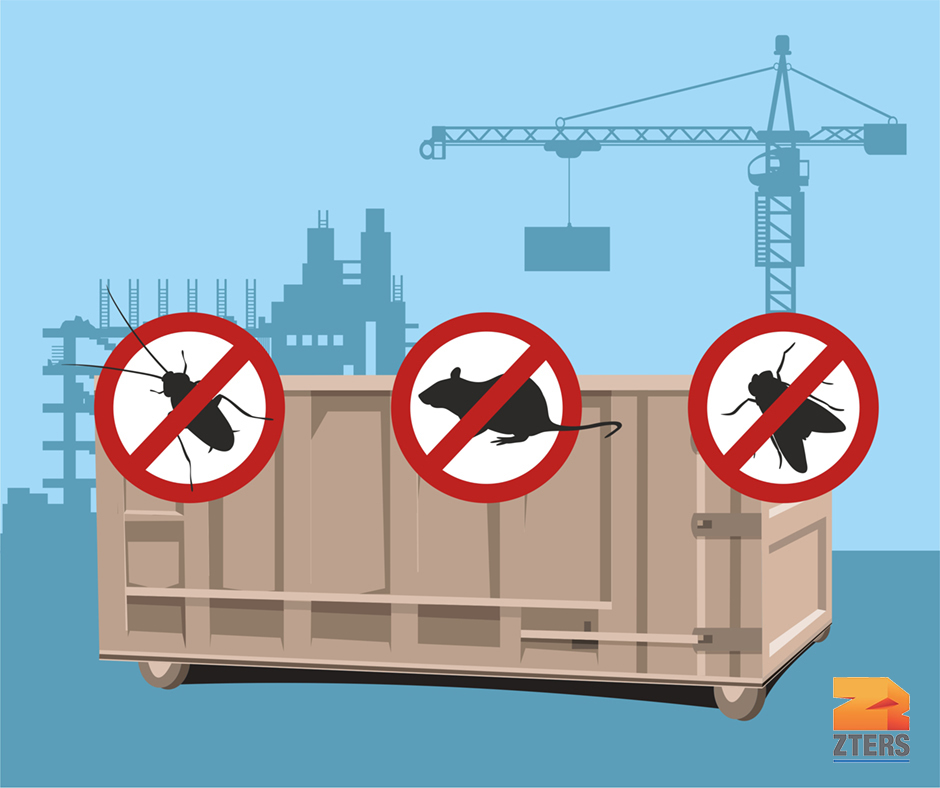Rats and roaches and raccoons. Oh my! Construction workers and business owners have enough to manage every day. A pest infestation in an outdoor dumpster can cause a major headache on top of that.
Many construction companies are unpleasantly surprised by termites feasting on disposed wood. Restaurants see a swarm of insects and rodents going after food scraps. No matter your industry, it’s important to be proactive about preventing a pest infestation in your dumpster. Bugs and other critters can set back your operations and pose a safety hazard.
Regardless of what type of dumpster rental you have on your site, there are steps you can take to reduce the risk of an infestation. Here are our top recommendations.
Keep your dumpster covered and locked if possible
First and foremost, limiting access into the dumpster will help safeguard it from unwelcome visitors. Try to keep it covered as often as possible and most definitely after working hours. A lock adds an extra layer of protection (from human dumpster divers as well). Raccoons especially are clever enough to get into trash receptacles that are closed.
Keep the dumpster at least 50 feet away from your office or building
Location is key. We offer augmented reality on construction sites in the free ZTERS app to help you find the ideal spot to accommodate your dumpster and minimize pest infestation.
Even worse than having pests in your outdoor dumpster is having them in your workspace–whether that’s a portable office or commercial building. Keeping your dumpster at least 50 feet away (ideally 100 feet) from your office helps keep pests away from your interior workspace should they show up. This can also reduce odors from impacting your workspace.
Avoid exceeding the dumpster’s weight limit
Overfilling a dumpster makes it harder, if not impossible, to close the lid. There’s a reason why dumpsters have a maximum tonnage. Not only does it help haulers pick it up and take it to a landfill or recycling center easily, but it also helps ensure that excess weight doesn’t compromise the dumpster’s sturdiness.
While dumpsters are made with heavy duty materials, overfilling them with heavy materials can potentially cause damage. This could make the dumpster more susceptible to an infestation. (It may incur additional costs.)
ZTERS tested smart dumpster camera technology to monitor waste volume and help our customers make their pickup schedule more efficient. If you find yourself filling up dumpsters quickly, it may be good to rent an additional one or adjust your pickup schedule. This makes it so pests are less likely to gather.
Place your dumpster on a solid, flat surface (not grass or dirt)
In addition to augmented reality in our free app, we published an article about where to put a construction dumpster based on our decades of experience. We strongly recommend placing the dumpster on a solid, flat surface. If there isn’t a concrete or asphalt surface, put down some plywood or a solid base. Grass or mud accumulate moisture, becoming a breeding ground for pests.
When it comes to preventing a pest infestation in your dumpster, use your best judgment. Weather can also be a large factor as fruit flies and other insects are most active in heat and humidity. It’s best to be proactive to avoid an infestation altogether, but sometimes pests find a way! Take the above steps to help reduce the likelihood of an infestation and ensure that your dumpster rental is hassle-free.

